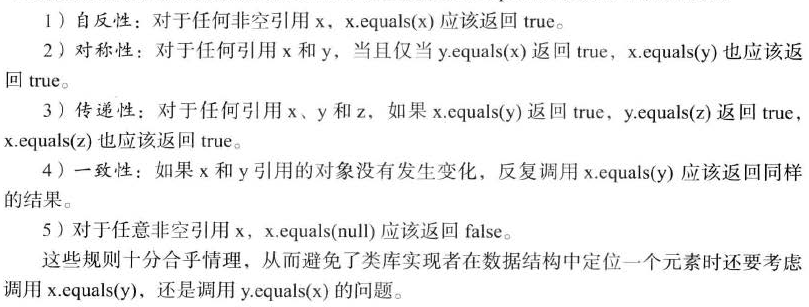Java之hashCode的作用和equals方法的重構規則
阿新 • • 發佈:2017-12-12
ide return 一點 eset log 什麽 bsp amp person
這個是博主對hashcode的初步理解,以後加深了會再來更新:
1、hashcode是什麽?
hashcode是對象的散列碼,不同的對象幾乎不一樣,說幾乎是因為還是可以一樣的。
特點:每一個對象都有hashcode,默認的值是每一個對象的地址。
2、hashcode的作用:
博主已知的方便用戶使用散列表插入數據,我們知道,集合有兩種,list----可重復,set----不可重復。
其中set實現不可重復就需要使用到hashcode和equals方法。
散列表set是使用鏈表數組實現的,每一個列表被稱作桶,而查找表中對象的位置使用的方法是:
1)、計算對象的散列碼hashcode;
2)、公式:hashcode%桶數=索引;eg:某一個對象的散列碼是76268,有128個桶,那麽對應的這個對象的位置就是在第108個桶中。
而在插入對象到散列表中的時候使用的是同樣的過程,只是這個時候可能會發現原有的位置被占用了,桶已經滿了,這個時候就需要equals方法進行判斷是否相等。
所以:
在重構equals方法的時候一定要重構hashcode方法,不然使用散列表的時候桶都找不到,更不用說下一步的判斷是否是同一個對象了。
下面是示例代碼:
public static void main(String[] args) {
String hello = "hello";
StringBuilder helloSB = new StringBuilder(hello);
String hello2 = "hello";
StringBuilder hello2SB = new StringBuilder(hello2);
System.out.println("hello‘s hashcode:" + hello.hashCode());
System.out.println("helloSB‘s hashcode:" + helloSB.hashCode());
System.out.println("hello2‘s hashcode:" + hello2.hashCode());
System.out.println("hello2SB‘s hashcode:" + hello2SB.hashCode());
Set stringSet = new HashSet();
Set sbSet = new HashSet();
stringSet.add(hello);
System.out.println("======" + stringSet.contains(hello2));
stringSet.add(hello2);
sbSet.add(helloSB);
sbSet.add(hello2SB);
Person person1 = new Person(1, "eke");
Person person2 = new Person(1, "eke");
Set personSet = new HashSet();
personSet.add(person1);
personSet.add(person2);
PersonWithHashCode code1 = new PersonWithHashCode(1, "eke");
PersonWithHashCode code2 = new PersonWithHashCode(1, "eke");
Set codeSet = new HashSet();
codeSet.add(code1);
codeSet.add(code2);
System.out.println(stringSet.size());
System.out.println(sbSet.size());
System.out.println(personSet.size());
System.out.println(codeSet.size());
}
運行結果:
hello‘s hashcode:99162322 helloSB‘s hashcode:39219479 hello2‘s hashcode:99162322 hello2SB‘s hashcode:2031787571 ======true 1 2 2 1
下面是PersonWithHashCode,Person和PersonWithHashCode相比只是缺少了hashCode方法。
貼這個代碼還有一點是重構了equals方法,這個方法的重構是要遵循一定規則的(圖片來自《java核心技術卷II》):

public class PersonWithHashCode {
private int id;
private String name;
public PersonWithHashCode(int id, String name) {
this.id = id;
this.name = name;
}
public int getId() {
return id;
}
public void setId(int id) {
this.id = id;
}
public String getName() {
return name;
}
public void setName(String name) {
this.name = name;
}
@Override
public int hashCode() {
return id * 24 + name.hashCode();
}
@Override
public boolean equals(Object object) {
if (object == this)
return true;
if (object == null)
return false;
if (getClass() != object.getClass())
return false;
PersonWithHashCode person = (PersonWithHashCode) object;
return this.id == person.id
&& Person.StringUtils.compare(name, person.getName());
}
static class StringUtils {
static boolean compare(String a, String b) {
if (a == null && b == null)
return true;
if (a == null && b != null) {
return false;
}
if (a != null && b == null)
return false;
return a.equals(b);
}
}
}
Java之hashCode的作用和equals方法的重構規則
